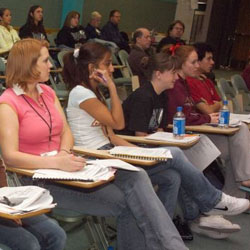
Among those who are not
enrolled in full-time college studies, more are completely unemployed
and looking for a job (30 percent) than have a full-time job (27 percent). Another 15 percent
are employed part time but looking for a full-time job.
About
half of the high school graduates between 2006 and 2011 have held a
full-time job at some point after receiving their diplomas. But at the
time the survey was conducted, in April 2012,
less than one-third held full-time jobs, encompassing just 17 percent of those
graduating during the recession-era years of 2009 to 2011.
“The
vast majority of recent high school graduates who are not attending
college have been left out of the workforce or even job training and
frankly are struggling to survive. Typically, they are either unemployed
entirely or working in part-time, temporary jobs that do not pay them
enough to earn even a poverty-level income,” said Professor Carl Van Horn,
director of the Heldrich Center and a co-author of the
study. “To make matters worse, many jobs that do not require a college
education are being snapped up by recent college graduates who are also
struggling to get a toehold in a slow job market.”
The median
hourly wage of the graduates’ first jobs after high school was $7.50.
Only 4 percent describe their first job as a career, and just 17 percent classify it
as even a possible stepping stone toward a career, leaving three out of
four taking the job “just to get by.” Even today, just 8 percent describe their current job as a career.
While
most graduates wanted to go to college when they started high school,
and many still want to go to college, financial realities have dashed
these hopes. When they started high school, nearly two-thirds believed
they “definitely” or “probably” would attend college. In fact, just over
one quarter — 29 percent — did so either on a full- or part-time basis. As of
the survey, none of the students report taking classes full time and 27 percent
are currently taking classes on a part-time basis. Even fewer — 5 percent —
are enrolled in a job training program.
With few working full
time and median earnings of only $9.25 per hour, recent high school
graduates are heavily dependent upon the financial support of their
families for day-to-day living expenses. Nearly 6 in 10 are living with
their parents or another family member, and nearly half receive help to
purchase food.
These are some of the main findings of Left Out.
Forgotten? Recent High School Graduates and the Great Recession, a new
report from the John J. Heldrich Center for Workforce Development at
Rutgers, The State University of New Jersey. The Heldrich Center
interviewed a national sample of 544 high school graduates in April 2012, using the web-enabled KnowledgePanel conducted by GfK, of Palo Alto, Calif.
Cliff Zukin, professor of public policy and political science at Rutgers and co-author of the study commented, “The swath of American youth we are describing with this sample is enormous, on the order of 15 million people or more, who are largely invisible and whose status is little better than that of itinerant workers. This will remain a large policy problem even as the economy begins to recover.”
View the full report here.
Report Highlights
- Only 27percent have full-time jobs.
- Nearly one in three are unemployed and another 15 percent are employed part time but looking for full-time jobs.
- The annual earnings of those working full time are barely sufficient to keep them out of poverty.
- Ninety percent are paid hourly; the current median wage for those employed full time is only $9.25 — just two dollars above the federal minimum wage.
- Seven in 10 say that their current job is temporary.
_________________________________________________________________________________________________________
The
John J. Heldrich Center for Workforce Development is based at the
Edward J. Bloustein School of Planning and Public Policy, at Rutgers
University. It is one of the nation’s leading university-based research
and policy centers dedicated to raising the effectiveness of the
American workplace through improved workforce education, placement, and
training. The Center identifies innovative workforce practices and
practical policy changes that can help Americans receive the education
and training they need to be productive and prosperous in a global
knowledge economy. Learn more at www.heldrich.rutgers.edu .